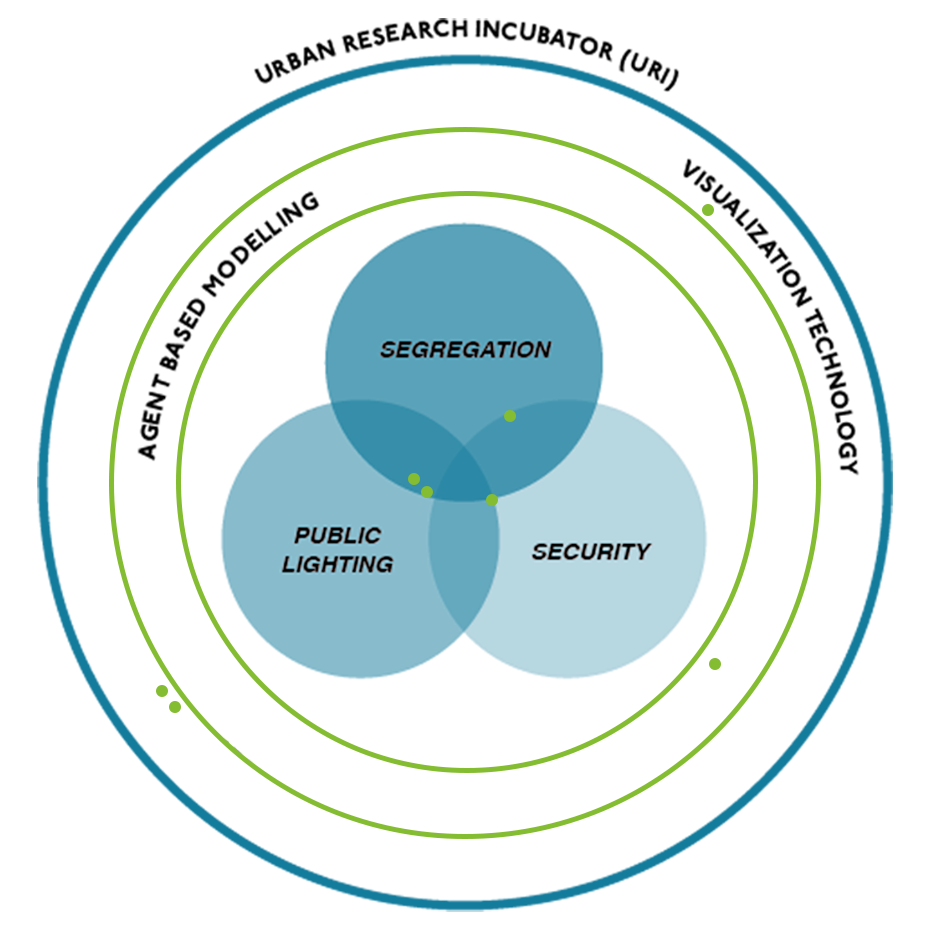Themes
URI researchers collaborate on a number of projects organised around three overlapping themes, segregation, security and public lighting which sit within a common methological framework of visualisation and agent-based modelling. URI projects are collaborative and interdisciplinary, using state-of-the-art modelling and visualisation technologies in order to address our guiding research question: “How can urban policy-makers leverage science and technology to create safer, more inclusive cities that serve the needs of all citizens?”.

Agent-based Modelling and Visualisation Technology
To advance and communicate research on these three themes, URI harnesses the use of state-of-the-art modelling and visualisation technologies. Agent-based Modelling (ABM) enables the study of emergent and potentially unexpected phenomena arising through the interaction of multiple actors with built and social environmental structures and processes, and to model scenarios to inform the development of integrated, multi-sectoral policy solutions. Alongside this, visualisation technology in the form of interactive 3D virtual environments, supports the communication of infrastructure policy options, aiding policy makers in the decision-making process.
Segregation
Sociospatial segregation is a major challenge for socioeconomically inclusive development in cities in the Global South, and especially in Bogotá and Cape Town. Both cities suffer from high economic inequality and its manifestation in space is the focus of URI. Cape Town, with its post-apartheid settlement structure – still divided along racial lines - has clearly marked patterns of sociospatial segregation, reproducing spatial structures of the past. Bogotá is a spatially divided city, supported by a segregating infrastructure provision system that makes sociospatial mobility hardly possible. URI aims at the micro scale of sociospatial segregation in both cities: How does infrastructure provision support or challenge segregation patterns in Cape Town and Bogotá? How does the rise of the gated communities shape a new landscape of micro segregation? How does insecurity contribute to segregated neighborhoods? Based on these questions, URI is developing policy recommendations and innovative design projects that are scalable and multipliable seeking to overcome sociospatial segregation in Bogotá and Cape Town and beyond.
Security
Insecurity remains one of the major challenges for cities of the Global South such as Cape Town and Bogotá. In both cities, the distribution of violent crime follows that of sociospatial inequality, being concentrated in the cities’ most deprived and marginalized neighbourhoods characterised by high levels of informality and inferior public infrastructure provision. At the same time fear of crime pervades all sections of society, resulting in the rise of fortified gated communities and prevalence of private security actors, which further exacerbate existing levels of inequality and insecurity. Against this backdrop, URI seeks to understand how different characteristics of the built and social environment – and efforts to modify these factors – impact on security. How can different forms of public lighting be implemented to reduce crime in informal settlements? To what degree, and for what reasons, do existing neighbourhood-level interventions focused on alterations to the built and social environment work to increase levels of security? How do physical manifestations of segregation shape the distribution of crime? The answers to these questions, and others, will inform the development of innovative policy recommendations to help increase security for urban dwellers in Cape Town, Bogota and beyond.
Public Lighting
Public lighting is often studied as a tool that can be used to reduce crime, or at least improve perceptions of safety. Yet, this overlooked public infrastructure may have a much broader impact on daily life, particularly in rapidly growing cities with large numbers of informal settlements that lack adequate access to public lighting and other services. With a particular focus on informal settlements in Cape Town and Bogotá, URI not only explores the relationship between public lighting and crime, but also investigates the many other possible functions public lighting can fulfill: What are the ways in which public lighting serves to define common or social spaces? How can public lighting improve the accessibility of space and infrastructure in informal settlements, especially shared infrastructure like communal water taps and toilets? Can smart public lighting technologies be used to enable geolocation services in poorly-mapped areas of cities so that they can receive emergency response services faster? Can smart public lighting be integrated into a robust disaster response and preparedness network that can improve resilience to climate change? URI uses a variety of qualitative and quantitative methods both in the lab and in the field to understand the multipurpose role public lighting can play in mitigating socio-spatial inequality, to evaluate different technological approaches to providing public lighting in informal settlements, and to develop scalable public lighting policy recommendations.